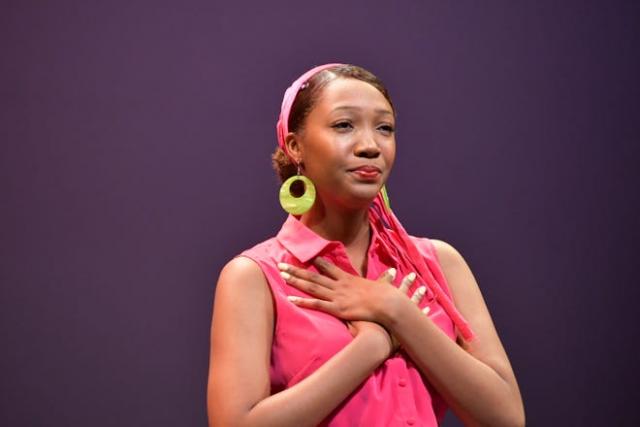
The first Milwaukee Black Theater Festival grew out of a response to the George Floyd killings of 2020. A few members of Milwaukee’s theater community gathered after the tragedy to discuss how to heal the community, and how to attract more black audiences to mainstream theaters that were considered primarily-white enterprises. Thus, according to co-founder Malkia Stampley (see below), the Milwaukee Black Theater Festival became the first of its kind, not only in Milwaukee, but throughout the Midwest.
In 2020, the first such festival was held virtually. It combined the talents of noted established Milwaukee Chamber Theatre staff (and its artistic director, Brent Hazelton), actor/director Malkia Stampley and actor/director Dimonte Henning (who is also artistic director of “Lights! Camera! Soul!”). Henning and Stampley, both Milwaukee natives, are frequently seen both onstage and off at many of the city’s theater companies. They had some definite ideas of what this type of festival could represent for people of color in the Milwaukee community.
This year’s festival was conducted under the theme, “The Strength and Resilience of the Black Woman.” The festival was a two-week event in August that contained two fully staged productions and a number of supporting theatrical activities.
One of this year’s highlights, playwright Charlayne Woodard’s Pretty Fire was held in one of Milwaukee’s prettiest theaters – the 350-seat Cabot Theater, which was donated to Milwaukee and designed after one of Europe’s exquisite jewel-box theaters. Within its elaborate faux-finishes and real-life ornamental fittings, the theater came vividly to life in this 90-minute autobiographical play.
As Woodard’s first play, it explores many of the themes she eventually develops in subsequent work. This is particularly evident in her second play, Neat. This second play, also a one-woman show, has been staged repeatedly in Milwaukee thanks to the multi-talented actor Marti Gobel.
While Pretty Fire in no way extinguishes Gobel’s brilliant performance in Neat, it provides some context for Woodard’s work. Both plays focus on the intertwining themes of faith, family and the trials of growing up black in early 1960s America. Woodard has won two Obie Awards and was nominated for a Tony Award for her own performance in the Broadway musical, Ain’t Misbehavin’.
Her own onstage experience allows Woodard to blend her very personal story of love, loss, innocence and hardship into a tale that is both uplifting and heartbreaking.
The staging for this version of Pretty Fire consists of a blank backdrop and a bench. During the play, audiences must use their imaginations to envision the same bench as everything from an apartment toilet to the driver’s car seat, from a hospital waiting room bench to a couch, from a windowsill to a church pew. These transitions are made with incredible speed, agility and gestures by Camera Stampley, a gifted actor who is still finishing her college schooling at Howard University.
Under Dimonte Henning’s skilled direction, Stampley effortlessly transitions from Charlayne to various other characters (both male and female), which consist of her immediate family members, distant relatives, church members, a pastor, older neighborhood boys, a shopkeeper, etc. Her performance is marked by unrestrained enthusiasm, which is shown most effectively when she portrays a young girl. In every “scene,” Stampley carries herself with a spirit that is poised for adventure. Even the darker chapters in her life do not seem to discourage her from a belief in goodness.
Growing up in New York, a young Charlayne discovers the reality of how black residents are treated in the American South. Each summer, she and her sister are driven by car to see her grandparents. Charlayne admits to being spoiled during those summers, when she and her sister are allowed to run barefoot after a rain, feeling the satisfying squish of mud between their toes. Even the promise of a new pair of flip-flops is enough to send her into a giddy mood.
At other times, Charlayne doesn’t quite understand why people in their predominantly black neighborhood are forced to hide inside their houses. One night, when she is brave enough to glance out a window, she sees a flaming cross on one end of their street. She calls it a “pretty fire.” Her grandparents, scared for their granddaughters’ safety, sternly reprimand Charlayne. They tell her that the cross is a sign of hate. The next day, when the danger passes, Charlayne walks over to the soot-black cross. She notes that it doesn’t look pretty any longer.
While some of the narrative pertains particularly to the black experience, enough universal aspects emerge that anyone growing up during that period can relate to. As a child, Charlayne describes the experience of watching movies starring Shirley Temple, especially ones that take place in “Dixie” (since, to Charlayne, “Dixie” refers to where her grandparents’ live). She is also enamored of the dog-star, “Lassie.” During these early years, Charlayne encounters taunts by school bullies, and has one particular scary episode when she is cornered alone by an older boy. Throughout her young life, she is guided by the common-sense advice of parents, aunties, uncles and grandparents. The final chapter of her story involves joining a church choir, in an effort to please her grandmother. Although she gets somewhat carried away by the effect her solo has on the church congregation, there is always someone close by to bring her back to earth.
Without a real set, Pretty Fire relies heavily on ambient sounds both indoors and outside (sound by Christie Chiles Twillie), and special lighting effects, (lighting by Jared Gooding). The lighting during the cross-burning scene is particularly noteworthy. Stampley’s costume, consisting of a sleeveless, bright pink blouse, dangling earrings and white cropped pants, is by Trinae Williams-Henning.
It should be noted that pandemic protocols, including spaced seating and mask-wearing for audience members, were required during the event. However, the experience of seeing live theater, after so many months of online viewing, more than compensated for these safety measures.
